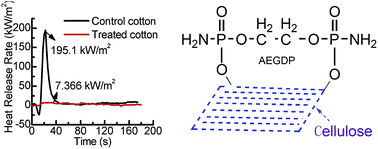Facile synthesis of an eco-friendly nitrogen–phosphorus ammonium salt to enhance the durability and flame retardancy of cotton
Abstract
An ammonium salt of ethylene glycol diphosphoric acid (AEGDP) containing nitrogen and phosphorus, a durable and eco-friendly flame retardant for cotton, was synthesized under moderate and solvent-free conditions. The AEGDP structure was characterized by IR, 13C NMR, 1H NMR, and 31P NMR. Thermogravimetry (TG) and TG-infrared (TG-IR) spectroscopy indicate that phosphoric or polyphosphoric acid produced from AEGDP during combustion could catalyze the dehydration of cellulose to form char instead of decomposing it to form volatile flammable species, which include hydrocarbons, some carbonyl compounds, and ethers. The degradation mechanism of cotton fabrics treated with AEGDP was modified because of covalent bonds formed between cotton cellulose and AEGDP. Scanning electron microscopy (SEM) shows that no obvious materials were observed on the surface of the treated cotton, indicating that the –P![[double bond, length as m-dash]](https://www.rsc.org/images/entities/char_e001.gif) O(O−NH4+)2 groups of AEGDP may react with the –OH groups of cellulose to form P–O–C covalent bonds and/or penetrate into the inner space of cotton fibers. Vertical flammable tests imply that the control cotton burned completely, whereas the treated cotton showed neither after-flame nor after-glow. The limiting oxygen index (LOI) of cotton treated with 120 g L−1 of AEGDP solution could reach 41.0%, which is significantly higher than that of the control cotton. After 50 laundering cycles, the LOI could be maintained at 28.4%, exhibiting the excellent durability of the treated cotton. Cone calorimetry at 35 and 50 kW m−2 irradiative heat flux reveals that AEGDP causes a reduction in the peak heat release rate and total heat release relative to those of the control cotton. In addition, X-ray diffraction shows that AEGDP fails to substantially change the crystal structure of cotton cellulose. There is no significant change in the bending length of cotton before and after treatment. And the decreased surface tension of the treated cotton is beneficial for its self-cleaning ability.
O(O−NH4+)2 groups of AEGDP may react with the –OH groups of cellulose to form P–O–C covalent bonds and/or penetrate into the inner space of cotton fibers. Vertical flammable tests imply that the control cotton burned completely, whereas the treated cotton showed neither after-flame nor after-glow. The limiting oxygen index (LOI) of cotton treated with 120 g L−1 of AEGDP solution could reach 41.0%, which is significantly higher than that of the control cotton. After 50 laundering cycles, the LOI could be maintained at 28.4%, exhibiting the excellent durability of the treated cotton. Cone calorimetry at 35 and 50 kW m−2 irradiative heat flux reveals that AEGDP causes a reduction in the peak heat release rate and total heat release relative to those of the control cotton. In addition, X-ray diffraction shows that AEGDP fails to substantially change the crystal structure of cotton cellulose. There is no significant change in the bending length of cotton before and after treatment. And the decreased surface tension of the treated cotton is beneficial for its self-cleaning ability.



 Please wait while we load your content...
Please wait while we load your content...